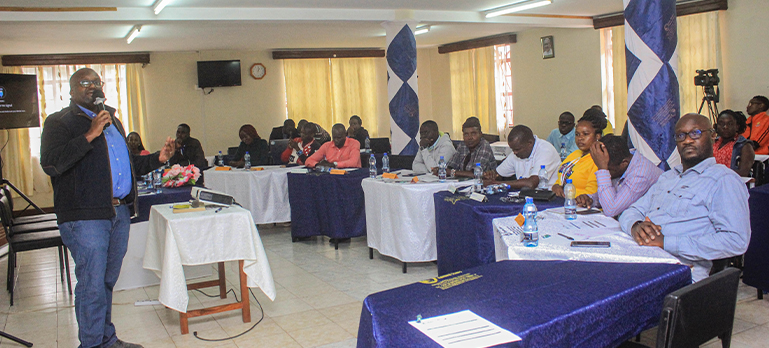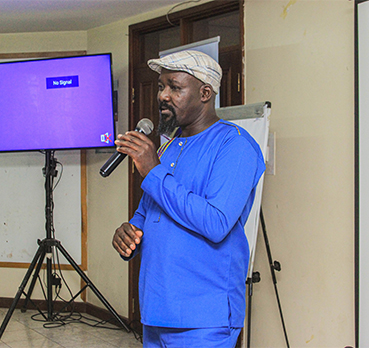Our County Our Responsibility

Telling Data Stories – Revealing Citizens Reality
Community Media Mobilizing for Accountability in Kenya
The CAMECO-led pilot project “Our County- Our Responsibility! Community media mobilizing for accountability in Kenya”, funded by the Federal Ministry for Economic Cooperation and Development (BMZ) for one year, has shown positive results in increasing civic participation, awareness and transparency on how local government budgets are spent. In 2010, Kenya adopted a new constitution, and voted to decentralize government. Forty-seven counties were created, and county governments negotiated a working relationship with the national government in terms of power and revenue sharing. Decentralization is to be based on three pillars: Participation of the population, transparency, and accountability. Every five years, each county submits a “County Integrated Development Plan”(CIDP), which defines the respective development areas, goals and budget lines. According to the Constitution, the development measures set out in these documents should also reflect the priorities of the citizens, which result from a participatory process in which citizens are involved, and their opinions and recommendations are taken into account.
However, the results of the pilot project confirm what had already been shown in supra-regional research: the concerns of the citizens in the eight selected target counties often contrast with the measures that have been decided upon. The majority of the population was not informed that so-called citizens’ forums were taking place in which the plans were to be presented and discussed. The CIDPs were not accessible two weeks before, as prescribed. The time frame for the forums was extremely limited, and left little room for dialogue and participation. The technocratic use of language and the complexity of the budgetary procedures were largely incomprehensible to those present, so that authentic and critical involvement by citizens was hardly possible. The “open government – open data” approach propagated by the government is inadequately implemented. Accountability is largely neglected by county governments. Transparency is not established with regard to either the planned or the implemented development projects. Of the representatives of the population interviewed in the pilot project, 94% stated that nepotism and favoritism are rampant in their district administrations, and that embezzlement, corruption and misappropriation of funds are commonplace. Finally, the fact that district officials from six of the eight counties involved in the project were summoned by the Ethics and Anti-Corruption Commission (EACC) and the Director Public Prosecution (DPP) for corruption and misappropriation of funds is a clear indication of the lack of transparency and accountability of local governments.
In such a situation, the information and control function of local media plays a key role. They have the potential and opportunity to promote participation in debates and discuss the management of public affairs, as they have the most immediate and direct access to people, especially in rural communities.
In the pilot project, the Kenya Community Media Network (KCOMNET) and the social science research institute Jesuit Hakimani Centre (JHC) cooperated to enable 14 citizen radios in eight counties to understand the political process and the contents of the local development plans and their implementation. The main objective of the pilot phase was to motivate the population to participate actively in democratic decision-making processes and to demand good governance. Topics such as the mandate and role of public officials, processes of public participation, budget cycles, etc. were first conveyed to journalists, and then addressed in 42 radio productions and 24 theatre plays, uploaded on Sikika.net. In addition, JHC had previously interviewed the population about their previous participation level and their own main concerns, which were set out in a strategy paper for each of the eight counties.


On the basis of priority needs defined by KCOMNET, CAMECO developed, in cooperation with the radio network and the new partner Code for Africa (CfA), a civic technology, open data and data journalism NGO, a follow up project, which is planned from October 2020 until the end of 2023. The new project “Our County- Our Responsibility: Telling Data Stories – Revealing Citizen’s Realities” includes comprehensive training schemes (e.g. research techniques, data journalism, solution-oriented reporting), and the design of an IT-based online tool (County Data Information System – CDIS), which will be continuously maintained, thus creating data transparency for the development schemes of county governments. Cooperation with aspiring young journalists is being systematically expanded in the follow up project, to improve the political education of young people, and to incorporate their concerns into the public debate.
The project continues to include the 14 community radio stations in eight Kenyan districts (counties) that were already the focus of the 4209-pilot project. 56 program staff members, all of whom belong to the permanent core of the community radios, will take part in several qualification measures, be responsible for program production and the training of young journalists.
The selected community radios are all an integral part of their local communities and broadcast not only in English and Swahili, but also in various local languages (Kitaita, Borana, Samburu, Meru, etc.) They all belong to the “strong” member stations of KCOMNET (measured by an effective organizational structure, an attractive programme profile, a high degree of listener participation).
These 14 citizens’ radios are all owned by a non-profit civil society organisation. Their listeners are mainly marginalized groups in Kenyan society and the poor population in rural areas. For example: The participating radios in Nairobi are all located in low income settlements or informal settlements. Baliti FM in Isiolo was founded by the Foundation for Women Pastoralists (FOWOPAS) and gives women and young people a voice, addresses the conflict potential of the nomadic cattle, access to resources and large infrastructure projects (LAPSET), etc. The same applies to Wajir Community Radio, founded as a voice and information platform for illiterate cattle-herding nomads. Amani FM in Tana River County broadcasts mainly peace and development programmes. (Tana River is one of the poorest and most neglected counties in Kenya and is also considered the deployment area of Al- Shabaab, the educational level of the citizens of Tana River is significantly below the Kenyan average). Ekialo Kiona FM known as EK-FM, a radio by and for young people, broadcasts from the cultural center owned by the inhabitants of the Mfangano Islands. In addition to health programs for this fishing dominated area, the radio also promotes the otherwise neglected Suba culture and language.
Stations Included in the project
- County Nairobi: Koch FM in Korogocho (estimated listenership: ca. 100,000), Mtaani Radio in Dagoretti (ca. 150,000), Ghetto FM in Majengo (ca. 150,000), Ruben FM in Mukuru ca. 150,000), Pamoja FM in Kibera (ca. 200,000);
- County Isiolo: Baliti FM (ca. 300,000) und Shahidi FM in Isiolo (ca. 200,000);
- County Kajiado: Domus Mariae in Ngong (ca. 120,000), Bus Radio in Kajiado (ca. 50,000);
- County Homa Bay: Ekialo Kiona FM auf Mfangano/Viktoriasee (ca. 100,000);
- County Taita Taveta: Mwanedu FM in Voi (ca. 300,000);
- County Tana River: Amani FM in Garsen (ca. 180,000);
- County Wajir: Wajir Community Radio in Wajir Stadt, (ca. 270,000);
- County Samburu: Serian FM in Maralal (ca. 150,000).
Each of these stations will also cooperate with one of the journalism clubs of a secondary school in their coverage are. These students will participate in the documentation of development projects and will also be involved in the production of special programs for young people. The stations will also host journalism students who will study at various universities located in Kenya (Daystar University, Institute of Social Communication/Tangaza University College, Aga Khan University) and will be required to complete a compulsory internship as part of their curriculum. Inquiries from the universities have already been received. The journalism students will also be included in the production of the program, which will focus on local development issues from the youth perspective. A manual on local journalism will be published, which will include examples of good practice in the process of improving reporting and content, and will be available to all local journalists in the country, but especially to journalistic training institutions.


